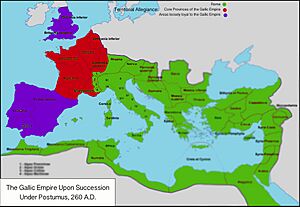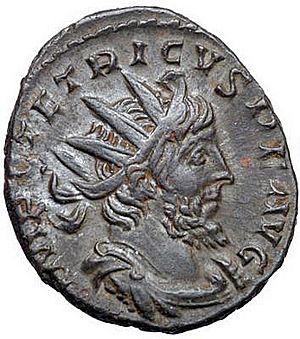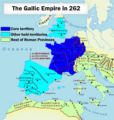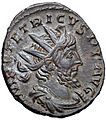Gallic Empire facts for kids
Quick facts for kids
Gallic Empire
|
|||||||||
|---|---|---|---|---|---|---|---|---|---|
| 260–274 | |||||||||
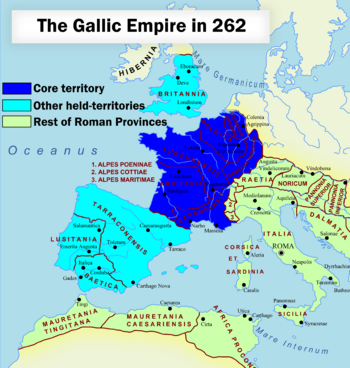
The Gallic Empire under Postumus by 262 (in blue), with the Roman Empire.
|
|||||||||
| Capital | |||||||||
| Common languages |
|
||||||||
| Government | Mixed, functionally absolute monarchy | ||||||||
| Emperor | |||||||||
|
• 260–269
|
Postumus | ||||||||
|
• 269
|
Marius | ||||||||
|
• 269–270
|
Victorinus | ||||||||
| Historical era | Late Antiquity | ||||||||
|
• Established
|
260 | ||||||||
|
• Battle of Châlons
|
274 | ||||||||
|
|||||||||
The Gallic Empire was a part of the Roman Empire that broke away and acted like its own country. This happened from 260 to 274 AD. It formed during a very difficult time for Rome, known as the Crisis of the Third Century. During this crisis, many Roman military leaders and important people declared themselves emperors. They took control of areas like Gaul (modern-day France) and nearby regions. However, they did not try to take over Italy or the main Roman government.
The Gallic Empire was started by a man named Postumus in 260 AD. This was after many attacks by barbarian groups and a lot of trouble in Rome. At its biggest, the Gallic Empire included parts of modern-day Germany, France, Britain, and even Spain for a while. After Postumus was killed in 269 AD, the empire lost much of its land. But it kept going under a few more emperors. Finally, the Roman emperor Aurelian took it back after a big battle in 274 AD.
Contents
History of the Gallic Empire
How the Empire Began
The Roman Empire faced a huge crisis in the 200s AD. The Emperor Valerian was captured by the Persian Empire in a battle. This left his son, Gallienus, in charge, but his power was very weak. Around the same time, a leader from Palmyra (a city in modern Syria) took control of a large area in the east. This area included places like Egypt and Syria. Even though he said he was loyal to Rome, his land was basically independent. It is now called the Palmyrene Empire.
Meanwhile, in the west, governors in a region called Pannonia tried to rebel. Emperor Gallienus had to go to the Danube River to deal with these problems. This left Postumus in charge of the Rhine River border. Postumus was a very good leader. He had successfully defended his area from attacks by the Franks in 260 AD. He defeated them so completely that there were no more attacks for ten years. All of this made Postumus one of the most powerful men in the western Roman Empire.
Gallienus's young son, Saloninus, and a top official named Silvanus were in Colonia Agrippina (Cologne). They were there to keep the young prince safe and perhaps to watch Postumus. But Postumus soon attacked Colonia Agrippina. He killed the young prince and his guardian, making his rebellion official. Postumus likely made Colonia Agrippina or Augusta Treverorum (Trier) his capital city. Lugdunum (Lyon) was another very important city in his new empire.
Postumus did not try to take over Italy or remove Gallienus from power. Instead, he created his own government, just like Rome's. He had his own special guard, two officials called consuls chosen each year, and probably his own senate. Postumus was a consul five times during his rule.
In 263 AD, Postumus successfully fought off an attack by Gallienus. After that, Gallienus never challenged him again. However, in 269 AD, Postumus faced a challenge from Laelianus, one of his own commanders. Laelianus declared himself emperor in Mogontiacum (Mainz). Postumus quickly took back Mogontiacum, and Laelianus was killed. But after the battle, Postumus was killed by his own soldiers. They were reportedly angry because he would not let them loot the city.
After Postumus's Rule
After Postumus died, an officer named Marcus Aurelius Marius became emperor. But he ruled for only a very short time, perhaps just a few months. Next, Marcus Piavonius Victorinus took power. He was recognized as emperor in northern Gaul and Britain, but not in Spain. Meanwhile, the Roman Emperor Gallienus had been killed in 268 AD. His replacement, Claudius Gothicus, brought some parts of Gaul back under Roman control. It seems that the provinces in Spain also rejoined Rome at this time.
Victorinus spent most of his time fighting rebellions and trying to get back the lands that Claudius Gothicus had taken. He was killed in 271 AD. But his mother, Victoria, took control of his soldiers. She used her power to help choose the next emperor. With Victoria's support, Gaius Pius Esuvius Tetricus became emperor. He was recognized in Britain and the parts of Gaul that had supported Victorinus. Tetricus fought off Germanic barbarians who were attacking Gaul after Victorinus's death. He also managed to take back more parts of Gaul. This happened while Claudius Gothicus's successor, Aurelian, was fighting the Palmyrene Empire in the east.
Tetricus set up his main court in Trier. In 273 AD, he made his son, also named Tetricus, a junior emperor. The next year, his son became co-consul with him. However, the Gallic Empire was becoming weak from problems inside, including a rebellion led by a man named Faustinus. By this time, Aurelian had defeated the Palmyrene Empire. He then planned to take back the western lands. Aurelian moved into Gaul and defeated Tetricus at the Battle of Châlons in 274 AD. Some stories say Tetricus offered to surrender before the battle if he and his son would be spared. Whether true or not, Aurelian won, and the Gallic Empire ended. Aurelian did not treat his victory as if he had defeated a foreign enemy. Many officials from the Gallic Empire, including Tetricus, continued their careers in the Roman government.
Why the Gallic Empire Formed
The Gallic Empire showed how much power was breaking apart during the Crisis of the Third Century. It also showed that the western provinces wanted more control over their own affairs. People in Gaul, especially landowners, wanted stability and protection. They supported the Gallic Empire because it offered a local Roman authority.
One of Postumus's main goals was to protect the border with the Germanic tribes. In 261 AD, he pushed back groups of Franks and Alamanni. He kept the Rhine River border safe. By doing this, Postumus showed himself as the defender of Gaul and a protector of Roman values. The people in these areas wanted Roman order and institutions. This desire for stability was strong, even if it meant being separate from the main Roman Empire for a time.
Important Gallic Emperors
We know about the Gallic Emperors mostly from the coins they made. Their stories help us understand the history of the Gallic Empire. Here are the main emperors:
- Postumus (260–269 AD)
- (Laelian was a challenger in 269 AD)
- Marius (269 AD)
- Victorinus (268/69–271 AD)
- (Domitian II was a challenger around 271 AD)
- Tetricus I (271–274 AD)
- Tetricus II (273–274 AD) - He was the son of Tetricus I and a junior emperor.
- (Faustinus was a challenger around 273/74 AD)
Some other names like Postumus the Younger and Victorinus Junior were once thought to be emperors, but they are now generally believed to be fictional. However, the existence of Empress Victoria was proven by finding her tombstone in 2012.
Images for kids
-
The Gallic Empire under Postumus by 262 (in blue), with the Roman Empire.


